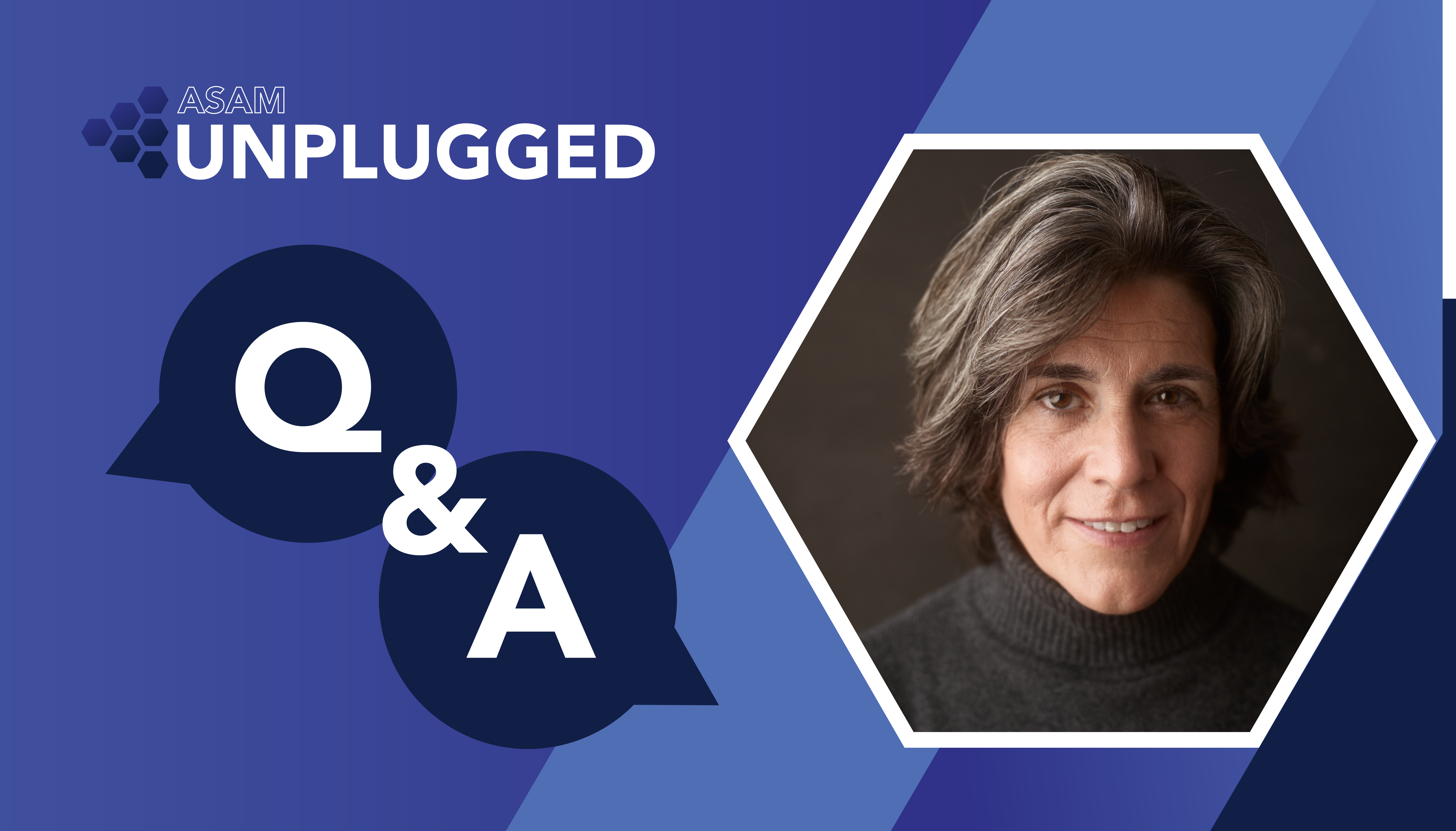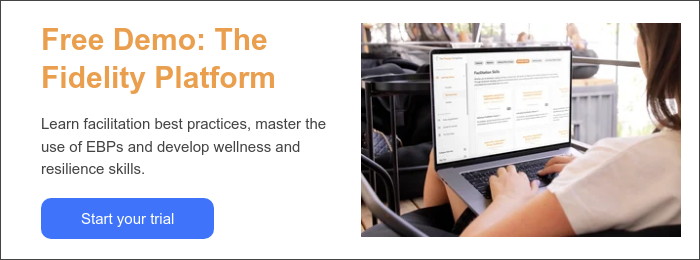ASAM Criteria Unplugged: A conversation with Kristin Dempsey

Gain unique access to behavior change leaders with our webcast series: ASAM Criteria Unplugged and Other Tales from the Field. Hear from leading experts in the field of substance use treatment, including Dr. David Mee-Lee, Dr. William R. Miller, Kristin Dempsey and many more.
Register here for our next ASAM Criteria Unplugged session, and watch past episodes on demand on the Fidelity Platform. Be the first to learn about upcoming webinars and open-registration events by signing up for our newsletter.
In Episode 3 of our ASAM Criteria Unplugged series, we had the pleasure of speaking with Kristin L. Dempsey, EdD, LPCC, LMFT. Kristin is a therapist, counselor, educator and trainer with 30 years of experience in evidence-based psychotherapy practices. In 2024, she also published The Harm Reduction Workbook for Addiction, a powerful self-help workbook designed to help participants create a personal recovery plan and build lasting change. The Harm Reduction Workbook focuses on skills- and strengths-based exercises and motivational interviewing (MI) to help readers uncover their motivations for change.
Sitting down with The Change Companies Chief Program Officer Valerie Bagley and Train for Change Senior National Director Scott Boyles, Kristin explores the benefits of harm reduction for addiction treatment and what it can look like to practice harm reduction as a provider.
Jump ahead to questions covered in this article:
- What inspired you to write the Harm Reduction Workbook for Addiction?
- When you use the term in the context of the title, what does "harm reduction" mean?
- How do we support meeting someone with where they are without "enabling" them?
- What might harm reduction look like for providers working with folks who are incarcerated in prison or jail setting, working under these very specific guidelines and policies?
- How does harm reduction apply with different special populations, such as indigenous communities, pregnant women, youth and more?
Q: What inspired you to write the Harm Reduction Workbook for Addiction?
Kristin L. Dempsey: "I've always loved clinician workbooks. I love to have something that takes a concept, sometimes a high-level concept, and really try to figure out and problem-solve for How do I actually make this useful for someone I'm serving?
I can tell people about things, but I actually want folks to engage and do something and explore. And we know the importance of — and we have good outcomes around — things like journaling, about being evocative. That's a big piece in motivational interviewing, of course, that helps people figure out where they want to go in terms of change. And workbooks are great opportunities for that. I had a lot of knowledge and experience in [substance use treatment], and it fit together to bring that expertise to this format."
Q: When you use the term in the context of the title, what does "harm reduction" mean?
Kristin L. Dempsey: "Harm Reduction with a capital H, capital R is also a social justice movement. And it's really built on the belief in and respect for the rights of people who use drugs... The book is really about... harm reduction with a small h and small r. It's a practical set of strategies and ideas that are aimed at helping people identify and use potentially different interventions or skills or behaviors that reduce negative consequences associated with drug use.
I like to think about harm reduction as being comprehensive in a lot of ways, and an important part of that is bringing in the provider. I think it requires this willingness and openness to be flexible… [Treatment] can take longer, but can certainly be more compassionate, and probably overall more successful over time, towards the person being served... And it's more compassionate towards the person providing care because we're not in this position of constantly having to be forcing something that someone doesn't want. That burns us out.
[Another] important piece around harm reduction is that it's not harm reduction versus something like abstinence. Unfortunately, it's been framed that way in a lot of our conversations. Abstinence is itself a type of harm reduction — a quite effective harm reduction piece, right? — like someone's not using at all. But there's all kinds of strategies that fit under an umbrella of harm reduction. And what's really great about that is then someone can really start choosing different types of things that they might be interested in or different programs, [including access to] safe using sites, clean paraphernalia… a lot of different things."
Q: How do we support meeting someone with where they are at without "enabling" them?
Kristin L. Dempsey: "If I am doing something that potentially "enables" someone to engage in more harm than, that's a problem, right? But what if I'm enabling them to move in a direction where they're getting more support?
Maybe I actually am giving them some extra care... like making sure that they have a place to stay or giving them some food. Maybe it's enabled them to stay engaged with me. Maybe I enabled them to see me as a resource. Maybe I enabled them to open up a little bit more. Maybe I enabled them to be a little more trusting. All those little pieces... [are] moving in the right direction of having them trust and be open and engaged more. That kind of enabling, if that's the word we're using, is what we want.
It's a real fear that comes up, that [harm reduction] work is promoting drug use... but it's [actually] promoting safety. So that's what we're enabling. We're enabling them to stay alive."
Q: What might harm reduction look like for providers working with folks who are incarcerated in prison or jail setting, working under these very specific guidelines and policies?
Kristin L. Dempsey: "I'm always honest and transparent with the person I'm serving about the boundaries of what we're working in, just so they can have expectations and be able to have some autonomy within the potentially strict limits of the system that they're in.
Then we can start being curious together about Is there a place for a small action item here? And I think this can happen even in the criminal justice or carceral systems. There might be places where even as employees, we can start thinking about [if] there [is] a different way we could do something that could be more flexible, that could be more humane, that could be more compassionate... Really thinking about: How is our carceral system helping or not helping folks who have relationships with substances? If someone's in a jail or in a prison, are they getting any kind of treatment? At any particular point, how does that work? And [what about] when people are discharged?... We have to be thinking about all the different stages of incarceration and post-carceration.
In the meantime, we can make small changes and advocate for the things that we know. For instance, like the ASAM [Criteria] — we recommend [and] continue to create that momentum for it."
For more on implementing the ASAM Criteria at your organization, check out the ASAM Criteria Implementation Guide or contact our team today.
Q: We've had a number of questions come in about this: How can harm reduction apply with different special populations, such as pregnant women, Native American communities, adolescents and more?
Kristin L. Dempsey: "I think those are really interesting questions that folks are coming in with, because what's happening there is we have people thinking, 'Well, this is all great! How do I do it with a community that I'm working with?' And I can see each of these having their own distinct kind of challenges.
We'll send you some really great harm reduction toolkits for specific populations and communities. I really encourage folks to check those out and see where might [harm reduction] really fit for the community [they're] working with.
In addition to a great toolkit, one thing that is important for everyone, as... part of trauma-informed care, is being culturally responsive. Being culturally responsive definitely comes into: What does this person want in terms of their choices around their substitutes and their life and their values based on their culture? So if you go and start to dig around as some of these resources, you'll find there's really a wonderful abundance of [harm reduction] resources, many of which are trauma-informed and culturally-informed."
Download the white paper: Harm Reduction Resources from Kristin L. Dempsey

